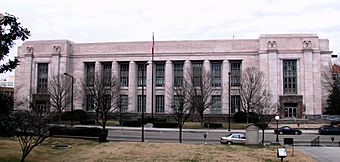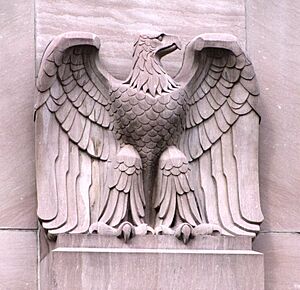United States Post Office and Courthouse (Knoxville, Tennessee) facts for kids
Quick facts for kids |
|
|
Knoxville Post Office
|
|
 |
|
| Location | 501 Main St. Knoxville, Tennessee, USA |
|---|---|
| Area | 1.9 acres (0.77 ha) |
| Built | 1934 |
| Architect | Baumann and Baumann |
| Architectural style | Moderne, Art Deco |
| NRHP reference No. | 84003567 |
| Added to NRHP | May 31, 1984 |
The United States Post Office and Courthouse, often called the Knoxville Post Office, is a special building in Knoxville, Tennessee, USA. It's located at 501 Main Street. This building was made in the early 1930s to be both a post office and a place for federal courts.
The building has cool designs from the Art Deco and Moderne styles. It's covered in beautiful Tennessee marble, which is a type of stone found nearby. Today, it's still used as a post office branch. The court parts are now used by Tennessee's state courts. This building is important enough to be listed on the National Register of Historic Places because of its unique look and its history.
Contents
Discover the Knoxville Post Office
The Knoxville Post Office is a large building with three floors. It takes up a whole block between Main Street, Locust Street, Walnut Street, and Cumberland Avenue. The building is about 250 feet (76 meters) long and 138 feet (42 meters) wide. It has a huge amount of space inside, about 123,000 square feet.
The first floor is mostly for the post office, where people send and receive mail. The floors above have courtrooms and offices. There is also a big parking lot behind the building, mainly for postal service trucks.
What Does It Look Like?
This building was built using six different kinds of Tennessee marble. This special stone comes from local quarries and has been used in many famous buildings across the United States. The outside of the building is mostly covered in "pink" Tennessee marble.
It has tall, impressive columns and cool, round designs along the roof. You can also see four amazing eagle statues carved by a sculptor named Albert Milani. The main entrances are at the corners of the building. The front has modern aluminum windows and a sunken courtyard. A wall made of red Tennessee marble surrounds this courtyard. It also has fancy Art Deco lights on top.
Amazing Art Deco Details
Inside the building, you'll find many Art Deco designs. These include metal screens with flower patterns and floral designs above the entrance doors. On the upper floors, there are aluminum panels with flower and zigzag shapes. The original ceiling had aluminum moldings with flower and zigzag patterns too. However, this ceiling was covered up by a new tiled ceiling in the 1960s.
The first floor has a shiny marble floor. Its walls are decorated with panels made of marble, aluminum, and bronze. The courtroom floor is made of cork wood, which is a soft and quiet material.
How the Post Office Came to Be
The land where the Knoxville Post Office stands today was part of an area added to the city in 1795 by James White. By the late 1800s, there were several large homes on this spot. When the government bought the land for the post office, it was the home of a well-known doctor, Walter S. Nash, and his wife, Eva.
Knoxville's first federal building, the Old Customs House, was built in the 1870s. It was made bigger in 1910. But by the 1920s, Knoxville had grown so much that this building was too small for all the mail services needed.
Planning the New Building
In the late 1920s, the United States Congress set aside money to build new post offices across the country. Senator Kenneth McKellar and Congressman J. Will Taylor, both from Tennessee, worked hard. They made sure some of this money came to Knoxville for a new post office and courthouse.
The new building was designed by Baumann and Baumann. This was a famous local architecture company that had also designed the Andrew Johnson Hotel nearby. The main architects were Albert Baumann, Sr., and his son, Albert Baumann, Jr. Albert Baumann, Jr., had studied architecture at the University of Pennsylvania. The design for the Knoxville post office was likely inspired by a model from the government's Treasury Department.
Building and Opening Day
The A.W. Kushe Company from Detroit was chosen to build the new post office. Construction started in December 1932 and finished in February 1934. On February 15, 1934, there was a special ceremony to open the new building. Congressman Taylor and Knoxville Mayor John O'Connor were there. The new post office officially opened about a month later, on March 11, 1934.
Changes Over Time
The Knoxville Post Office was updated in 1964. During this time, a lower, tiled ceiling was put in. In the 1990s, most federal court activities moved to a different building. This new building was called the Howard Baker, Jr., Federal Courthouse.
In 2003, the post office building was renovated again. This work was done by Denark Construction, following designs by Cope Associates. These updates included remodeling the first floor. They also improved the spaces for the different offices. The building still works as a branch post office today. The courthouse part now holds the Tennessee State Criminal Court of Appeals and a section of the Tennessee Supreme Court.
The post office is even mentioned twice in a book called Suttree by Cormac McCarthy. In one part, the main character goes through the long hallway to get out of the cold. In another scene, a man who travels with goats is told off by a police officer for letting his goats eat grass on the post office lawn.




